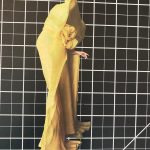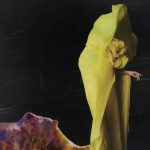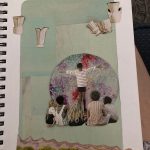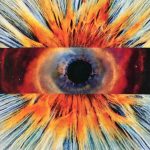Hi, this is a pretty niche post. It started as a comment in a Discord channel about a beloved fantasy book series but quickly expanded into something longer, so I thought it might be best as its own post.
Context: There’s an excellent book originally published in 1989 that seems to be making the rounds this year called The Steerswoman by Rosemary Kirstein. Currently there are four books published in the series with a few more to come, as I understand. The series is fantastic. I’d recommend it to people who like high fantasy, speculative fiction, mysteries, quests, heists, warrior societies, knowledge production, sociology, anthropology, landscape as a character, and riffs on any of the above. The series is all of those things—and a lot more that I don’t want to say. The worldbuilding is so thorough and it’s a delight to experience it unfold. So, you know, in case you want to read it, I won’t say any more.
What follows may contain light spoilers because it’s written for people in the Discord who have at least completed the first book, but I kept foreshadowing to a minimum. Here’s a link to the passage of the book with the reading (note this is from a different edition of the book, The Steerswoman’s Road, which contains the first two books in the series). I’ll also insert quotes in italics as we go through the reading. The characters in this excerpt are Rowan, a Steerswoman (collector and producer of knowledge); Bel, an Outskirter who comes from relative terra incognita; and a mysterious jewel that is driving the direction of Rowan’s journey.
As the scene is introduced, Bel and Rowan are resting for the night. Rowan is trying to puzzle out a seemingly unsolvable problem using logic and evidence, but still can’t make sense of it. Bel suggests consulting the cards because logic is not the only way of knowing. Rowan knows the cards (Steerswomen know a lot) but doesn’t believe in their accuracy. Bel searches through the deck to find The Fool and sets it before Rowan. The Fool is the first card in the deck and many interpret this archetypal figure with a happy-go-lucky meaning. Generally The Fool stands for lightheartedness and trust that things will work out, maybe despite their actions. Personally, I took this as a gentle dig at Rowan. Rowan doesn’t believe, so Bel finds The Fool and places it before her in good fun. Like, “Here’s you, represented in the cards you don’t believe in.” 🙂
At this point, Bel is just shuffling the cards, there’s no sense of intent at taking any of this further. Rowan changes the dynamic at play and decides to place the mysterious jewel on top of The Fool. To me this now becomes a serious question about the journey of the jewel. The reading begins in earnest. Rowan believes the reading will be about the jewel itself, but I think Bel knows it is about Rowan’s journey surrounding the mystery of the jewel.
Bel will lay out the cards in a modified Celtic Cross spread (I’ll note the modifications as they come up). There are already a lot of variations about how to read this spread so I’ll be doing it my way, which is itself slightly modified from tradition, probably. Tarot is a living practice and every reader uses their own intuition to find the ways that work for them.
This is the spread that Bel will pull.
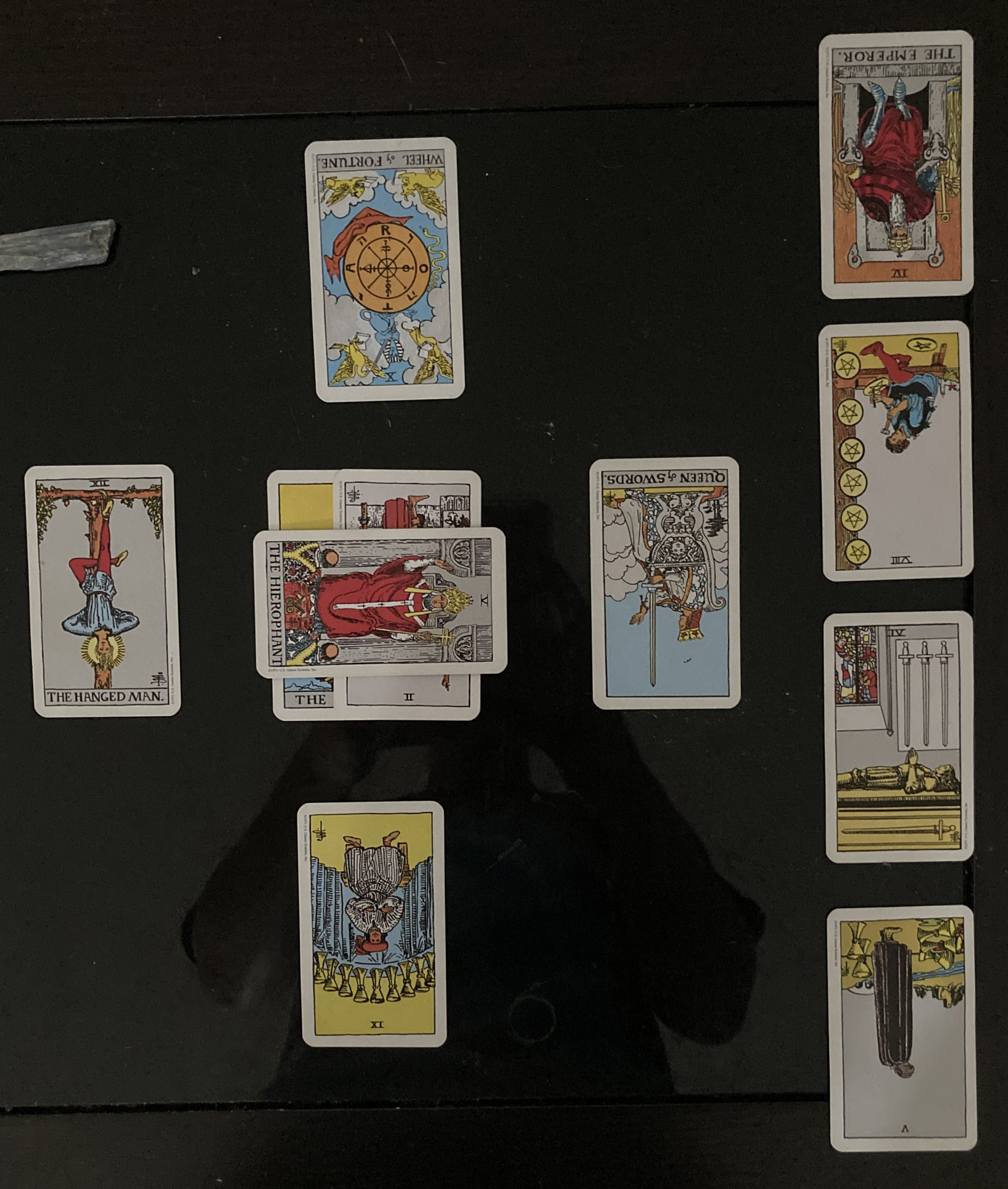
In tarot readings, the shuffled and cut deck is kept face down, cards are drawn one at a time and only revealed as they are placed in their spot in the spread.
In the Celtic Cross, the first card drawn represents the querent, the person asking the question of the cards. The Fool was not drawn from the shuffled deck, instead it was sought for and pulled out by Bel, then activated by Rowan’s addition of the jewel. This is the first way that this reading differs from a typical one, but it makes sense in this context. Since Bel and Rowan have now contextualized this as the journey of the jewel, this stands for the querent.
The first card drawn from the shuffled deck is the Two of Rods (Wands), reversed. Bel moved the blue gem to one side and placed the card on top of the Fool. “The situation,” Bel began, “is controlled by others, a domination that causes suffering.”
Here we have another modification of the Celtic Cross spread, again because of the initial removal and activation of The Fool. Bel places this card across The Fool, making the Two the card that represents the obstacle or challenge facing the querent. The Two of Rods would also make sense as a querent card, though I’m only seeing this in hindsight, having seen where the story goes in the following books.
The Two of Rods is a very powerful card, in my opinion. I spent a lot of time thinking about how to represent the powers at play in this card for my deck. I disagree with Bel’s interpretation, though the card in that position still makes sense. To me the Two is a card of exploration, generative imagination, and invention. I read this as a discovery of unimaginable proportions, like a paradigmatic shift in knowledge.
Next Bel draws The Priest which is an old styling of what is now commonly The Hierophant. She lays it on top of the first two. Again, this is a modification to the spread due to the inclusion of The Fool—normally there are only two cards placed in this central position, not three. In the layout above, you can’t really see the three in the center that are overlaid, so here they are in detail. I even have a piece of blue kyanite to hold the place of the jewel 🙂

Bel reads this card as how to counter the challenge of the domination she sees in the Two—by conforming to expectations. I again think there is a different interpretation of this card as a clarifying card for the Two of Rods/situation. In ancient decks, The Hierophant was called The Priest or The Pope. There are two figures in the foreground of the card who are learning from the main figure, so this card has an aspect of sacred teaching and learning. However, there is an undeniable spiritual aspect to this card. In concert with the paradigmatic knowledge shift that the Two predicts, I’d say the appearance of the Priest is suggesting that even sacred or unquestionable knowledge may be shaken.
She placed the next card in position above the first two [sic]. “Fortune, reversed. A bad turn of luck.”
The Wheel of Fortune is exactly what it sounds like, and in this case I might take the reversal into consideration. Maybe not as a certainty of bad luck, but emphasizing that, like, literally anything can happen and be prepared to be surprised. Bel has placed this card above the central pile of three, which in the spread represents the conscious or visible influences.
The next card was the nine of cups, reversed. “At the root of the matter, an imperfection in plans.”
Kirstein doesn’t tell us the placement of this card, but based on Bel’s contextualization as the root of the matter, I believe it is below the central pile of three—this position represents the unconscious or hidden influences at play.
I, again, don’t take Bel’s interpretation from the Nine of Cups. As a suit, the Cups have to do with emotions. In the Rider-Waite-Smith deck I’m using here, the imagery is a figure sitting cross-armed in front of a table with nine golden cups, almost guarding them. I’d read this card as hoarding, protection, and secrecy. That would change what is at the root of the matter drastically.
The Hanged Man. “Suspension. There has been a period of waiting, of suspended decision, but this is now ending.”
I was excited about the appearance of this card. It’s another one of my favorites. Again Kirstein doesn’t say where in the spread this card is placed, however I’d infer that it would be to the left of the central group representing the querent and the situation. The card in that position represents the past, and Bel’s interpretation is spot on.
Encouraged by Rowan’s serious expression, Bel continued. “The queen of swords, reversed. Narrow-mindedness, intolerance . . . these are the influences now coming into effect.”
Again, I’m inferring the position here as to the right of the central group, representing the near future. I think Bel’s interpretation works with this card, though she might be leaving out an emotional aspect typically attributed to the Queen cards. So maybe also a little spite and revenge at play.
At this point the cards form the cross—the core of the situation as it exists. The next four cards are called the staff and they are typically laid out to the right of the cross in a straight line, starting from bottom to top (I think there’s an editorial mistake with the way the layout of the staff is described in the text.)
For the lowermost position of the staff, the attitude of the querent about the issue, Bel pulls the Five of Cups, reversed.
Bel squinted at it, thinking. “A new alliance, or a meeting with an old friend, bringing hope.”
This is exactly why reversals are confusing! The Five of Cups is a card of loss. Bel’s interpretation is the opposite, presumably because it is reversed? Idk! I would interpret this differently, but I would also squint at it for a while first. The best I can do with this is maybe the querent has a fear of losing something important. The Five of Cups is definitely not a hopeful card, but it’s also not one of total hopelessness. Of the figure’s five cups, three have tipped over, but two remain upright. A partial loss. One goes on with the resources at hand.
Bel placed the next card above the previous. “Four of swords, that’s a period of rest, or recuperation, a withdrawal.” Bel looked dissatisfied, then brightened. “Of course! You’re going back to the Archives, where you’ll rest, see old friends, then gather your forces again.”
“Is this reading about the jewel, or is it about me?”
“Your fate is interwoven with its,” Bel said confidently.
Bel’s interpretation here is correct. Deep deep rest and recovery is what the Four of Swords represents. I think Bel’s conclusion about Rowan’s return to the Archives being that rest is a little hasty, but it makes sense for where they are in the story. The position this card holds as the second in the staff I always read as “What the querent needs to know.” At some point Rowan will need to retreat and process.
Now Kirstein plays a little trick on us and doesn’t tell us what card Bel draws next, only how she and Rowan interpret it.
She turned up the next card and put it in position. She looked at it for some moments, puzzled.
“Poor workmanship,” Rowan prompted. “Pettiness, mediocrity.”
“Yes, but it’s in the Spirit position. . . How can the spirit of the jewel be pettiness, or poor workmanship? Poor planning, perhaps?”
The card I immediately thought they drew was the Eight of Pentacles, possibly reversed. This card is about industriousness and skilled workmanship, showing someone literally creating coins with their hammer and workbench. Rowan’s characterization of it meaning “poor workmanship” specifically is what makes me believe it would be reversed for this reading. Rather than reading the card as literally representing mediocre workmanship, I’d think of it as poor planning or a failure in a plan’s execution.
Interestingly, Bel calls this card position, the third on the staff, the Spirit position. I know it as the Hopes and Fears position, and here is where I always do something a little different in the Celtic Cross reading. The final card that will go above Hopes/Fears is the Outcome (if things continue on their current path). It is very strange to try and figure out if a card in that penultimate position represents a hope or a fear before interpreting the outcome. So I tend to skip this card for a moment going from the Needs to Know card straight to the Outcome card. Then I return to interpret the Hopes/Fears card because this can sometimes be a long conversation as the querent thinks through the Outcome. As Bel says, “It’s very mysterious.”
“What’s the last card?”
Bel turned it up: the Emperor, reversed. “Dependence,” Bel said. “And danger. Either physical danger, or a threat to possessions.” Bel thought carefully for a while, obviously casting about for connections, that same search for patterns that Rowan had briefly followed. “I don’t see how the jewel itself can be in danger, so it must be that it carries danger. I think we should be very careful.”
The Emperor, to me, represents The System, the ruling order, the people in charge who want to stay in charge. I’d read this not as dependence, but as domination. The established order rules by force and will do anything to keep its power. The reversal here could signify that the establishment may be in danger of losing its power, but that doesn’t mean it won’t fight to try and right itself.
One of the most challenging things about reading a spread with so many cards is taking the segmented meanings of each card and its position in the spread and synthesizing it into something that is more cohesive. Here’s how I’d summarize what this reading tells us.
You are beginning a journey into the unknown, where what you will discover will change the very nature of knowledge itself. There is a guarded secret and your path as you seek answers literally cannot be predicted because the nature of the secret is in such deep shadow. Things have been in a holding pattern for a very long time but change is coming fast. People may not believe the things you learn and they may hate you for trying to reveal new truths. You may be apprehensive about the loss of your beliefs that may come with this journey. You may lose everything you thought was true and have to withdraw to find new truths. What you learn threatens the known order of everything, and those in power will hold back nothing to try and keep their position. Plan as well as you can with the knowledge you have, and be open to using what you will learn.


